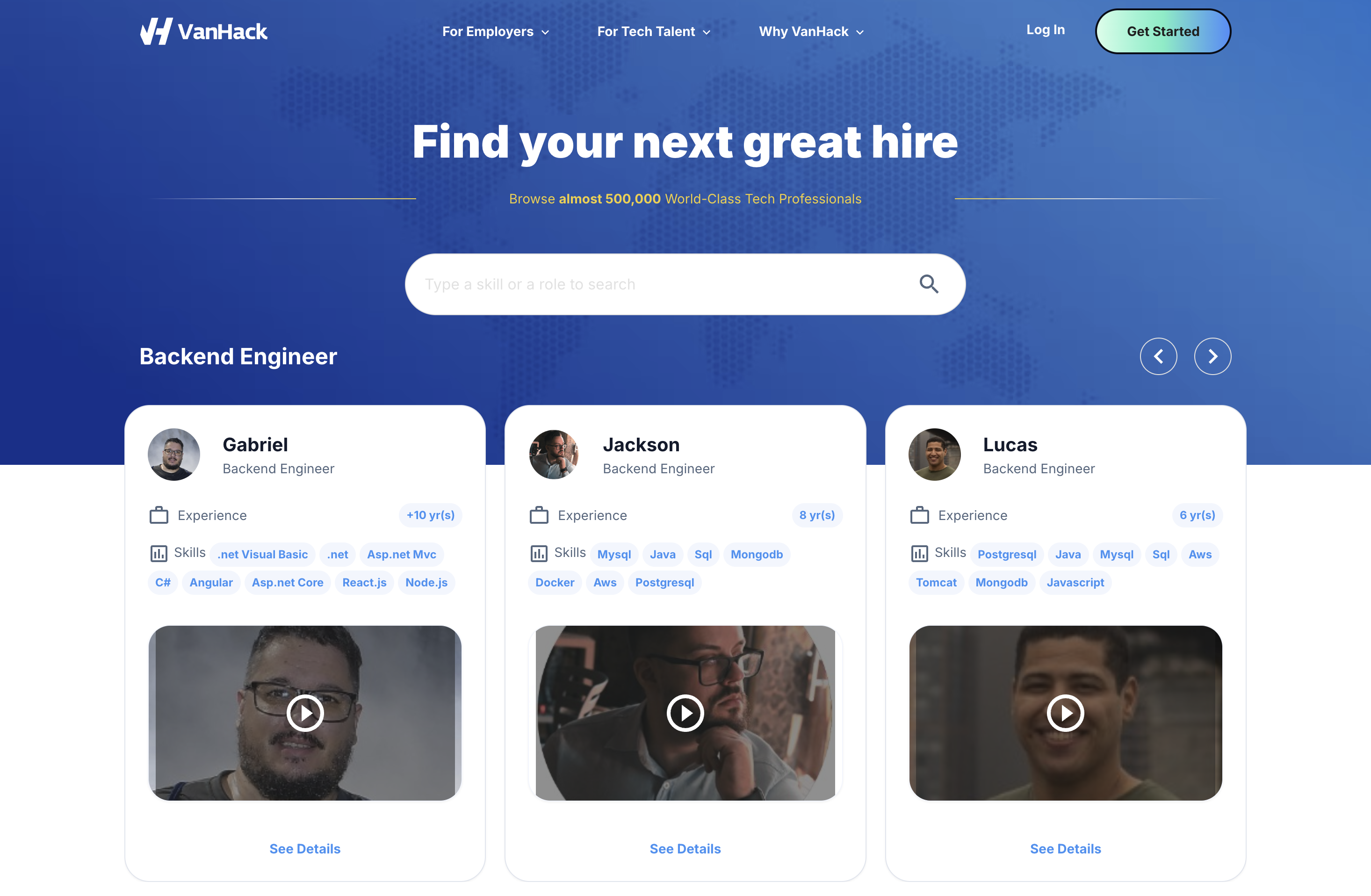Hiring skilled developers is a top priority for US startups aiming to grow quickly in a competitive market. Traditional recruitment often falls short when you need to scale fast with top technical talent. This guide offers a clear, practical approach for leaders looking to hire remote Latin American developers. You’ll find key insights, helpful strategies, and tools to align global hiring with your business goals. Ready to streamline your process? Hire faster with VanHack and build your dream team now.
Why Hire Remote LATAM Developers Today?
Facing Talent Shortages in the US Tech Market
US startups struggle to find enough qualified developers, with senior talent becoming harder to hire due to high demand and rising costs. The shift to remote work has opened up global options, but it also means fiercer competition for local hires. Sticking to traditional methods like job boards or general agencies often delays growth and limits access to skilled professionals.
Looking beyond borders isn’t just an option anymore; it’s a smart move for companies wanting to stay ahead. Tapping into international talent pools can help you scale quickly, save on costs, and access specialized skills that are scarce locally.
Key Benefits of Latin American Talent for US Firms
Latin America offers distinct advantages for US companies hiring remotely. Shared time zones allow for real-time teamwork during regular business hours, avoiding the delays often seen with teams in Asia or Europe. Cultural similarities also make it easier to collaborate and integrate developers into your workflow compared to other regions.
The region’s tech education has grown, producing developers skilled in current tools and practices. Cities like São Paulo, Mexico City, and Bogotá host thriving tech scenes with professionals who meet global standards. Plus, hiring senior developers in LATAM often costs less than in the US or Europe for comparable expertise, freeing up budget for other priorities.
Essential Terms for Tech Hiring Success
Knowing the difference between recruiting and talent acquisition sets the foundation for effective hiring. Recruiting focuses on filling open roles quickly, while talent acquisition builds a long-term strategy to support your company’s vision. This mindset is crucial when hiring remote LATAM talent.
Define engineering levels clearly to evaluate candidates. Senior engineers often have 5-7 years of experience and handle complex tasks independently. Staff engineers, with 7-10+ years, lead across teams and shape technical decisions. Principal engineers, with over 10 years, guide strategy and mentor others.
Compensation in LATAM usually centers on cash rather than equity, unlike some US norms. Offering competitive salaries is key to attracting skilled developers, as stock options are less common unless tied to US-based roles or specific incentives.
Exploring the LATAM Developer Landscape
Major Tech Hubs and Skills in Latin America
Latin America’s tech scene is booming, with several cities standing out as talent hubs. São Paulo and Rio de Janeiro in Brazil lead with strong university ties and active startup communities. Mexico City and Guadalajara in Mexico benefit from close ties to US markets and corporate partnerships.
Buenos Aires in Argentina shines for developers skilled in financial and enterprise systems, backed by solid academic training. Bogotá and Medellín in Colombia combine technical expertise with competitive costs, while Santiago in Chile focuses on fintech and boasts high English proficiency.
Across these hubs, developers are strong in areas like JavaScript frameworks, backend tools, cloud platforms, and mobile app development. Growing expertise in AI, fintech, and cybersecurity also makes LATAM talent a strong match for US project needs.
What to Expect with LATAM Developer Pay
Pay for senior developers in LATAM varies by country, skill set, and experience. For 2025, hourly rates often fall in these upper ranges: Brazil at $70-90, Mexico at $75-95, Argentina at $65-85, Colombia at $68-88, and Chile at $80-100. However, typical rates might sit lower due to local economic factors and competition.
Rates tend to be higher in bigger tech cities where living costs and demand rise. Specialized fields like AI or cybersecurity can add a 10-15% premium. To attract top talent, offer fair pay alongside growth opportunities, flexibility, and clear hiring steps.
Should You Build or Buy Your Hiring Process?
Creating an In-House Hiring Team
Setting up your own talent acquisition team gives you full control over hiring, culture fit, and long-term planning. Internal recruiters deeply understand your tech needs and can build direct connections with candidates from start to finish.
However, this takes a big initial investment. A skilled technical recruiter’s annual cost, including tools and subscriptions, can range from $120,000 to $180,000. It also demands expertise in global markets and cultural differences, which takes time to develop. This works best for larger firms with steady hiring needs, not smaller teams with limited budgets or sporadic roles.
Partnering with External Hiring Experts
Teaming up with external recruiters provides instant access to market knowledge, candidate networks, and tested hiring methods without building everything from scratch. Traditional agencies often charge 20-30% of a hire’s first-year salary, which can add up during fast growth. Many also lack specific focus on LATAM or tech talent.
This option suits companies with changing hiring needs or those needing niche skills internal teams can’t source. Newer models offer better pricing and services to overcome the drawbacks of older agency approaches.
How to Decide on Your Hiring Strategy
Choosing between building or buying depends on your company’s stage and needs. Mature firms with solid hiring systems can handle internal processes, while early-stage startups often gain more from external support and proven methods.
Consider your hiring volume and timeline. Planning to fill 10+ tech roles yearly might justify an internal team, but urgent or occasional needs are better served by flexible external partners. Budget, delays, and hire quality also factor into the decision, alongside metrics like time-to-fill and retention.
Top Tips for Scaling with Remote LATAM Engineers
Thoroughly Vetting and Assessing Candidates
Hiring remotely means going beyond resumes to evaluate talent. Check language skills for both technical and everyday communication. Look at remote work experience and collaboration styles to gauge fit, rather than just cultural surface traits.
Use consistent technical tests that mirror real job challenges. For senior roles, include system design discussions to test strategic thinking. Video calls and structured interviews reveal communication strengths early, saving time on deeper evaluations if there’s a mismatch.
Modern tools, like AI-driven interviews, offer detailed insights into problem-solving and skills with objective scores, cutting down on guesswork in the hiring process.
Smooth Onboarding for Remote Teams
Effective onboarding sets remote hires up for success with clear guidelines and communication norms. Before they start, ensure tech setups and team intros are ready. Pair new hires with a mentor for day-to-day support.
Help them adapt to team dynamics and decision-making through regular check-ins over the first few months. Detailed guides and async tools help them work independently despite time zone gaps, boosting productivity from the start.
Handling Legal and Payroll Challenges
Hiring across borders brings legal, tax, and compliance hurdles that differ by country. These can overwhelm firms without specific know-how. Employer of Record services manage these issues but may limit flexibility and add ongoing costs.
Direct hiring offers control and savings, yet requires navigating complex rules. Working with partners familiar with both US and LATAM systems can simplify compliance and cut administrative burdens.
Discover VanHack: Your Partner for Hiring LATAM Talent
VanHack simplifies hiring for US startups by connecting you with pre-vetted, senior developers from Latin America for remote roles. With access to a pool of over 500,000 tech professionals, VanHack delivers shortlists of 3-5 strong candidates tailored to your needs.

Through its Vanna AI platform, VanHack offers a $3,000 monthly subscription for unlimited hires, far less than traditional fees. For example, hiring 7 developers could cost $9,000 versus over $100,000 with typical models. Their vetting includes video assessments, AI interviews with transcripts, and standard coding tests to save you time.
For hires relocating to Canada or Europe, VanHack’s Global Mobility service covers visa processing and logistics like housing, at no extra cost. They also support integration with local community groups for relocated hires. Start hiring with VanHack to build your team efficiently.
Common Mistakes to Avoid When Hiring LATAM Talent
Overlooking cultural nuances can disrupt team cohesion. Even with shared traits, differences in communication or work-life expectations exist between LATAM and US cultures. Assessing these early prevents later friction.
Skipping in-depth technical checks can lead to performance gaps. Relying only on resumes or basic tests misses deeper skill issues, costing time and morale. Comprehensive vetting is essential for long-term success.
Inadequate onboarding creates remote work challenges. Treating remote hires like local staff without tailored support slows integration. Design specific processes to bridge distance and build connections.
Ignoring international hiring laws risks penalties and disruptions. Tax or compliance errors can be costly without expert guidance. Seek support to handle these complexities properly.
Not tailoring your employer brand to LATAM talent limits appeal. Developers value growth, team quality, and mission over just pay. Generic job posts often fail to attract the best candidates in a crowded market.
Are You Ready to Hire Remotely from LATAM?
Assess your company’s readiness before diving into remote LATAM hiring. Firms with strong management, clear processes, and remote team experience can integrate talent smoothly. If these aren’t in place, build internal skills first.
Align key stakeholders like CTOs, HR, and executives early to avoid delays. Prioritize roles that drive immediate business impact for the best return on your hiring efforts. Compare your internal strengths with external support needs using clear criteria.
Plan timelines around product goals and market needs, as global hiring often takes longer. Find the right talent now with VanHack’s platform and tailored services.
Common Questions on Hiring Remote LATAM Developers
How Can US Firms Ensure Cultural Fit?
Ensuring cultural fit with LATAM developers means focusing on remote work readiness and communication skills. Look for candidates experienced in distributed setups and familiar with US work styles. Video intros help spot adaptability early.
Use behavioral interviews to explore how candidates handle remote challenges like time zones or cross-cultural teamwork. VanHack’s process, with video and AI assessments, helps pinpoint those who’ll succeed in diverse, remote settings.
What Are Typical Hourly Rates for Senior LATAM Developers?
Senior developers’ hourly rates in LATAM depend on location and expertise. Upper ranges for 2025 often include Brazil at $70-90, Mexico at $75-95, Argentina at $65-85, Colombia at $68-88, and Chile at $80-100. Typical rates might be lower based on market factors.
Niche skills like AI or fintech add a 10-15% premium. Budget for these roles while noting the value they bring compared to higher US rates.
Do LATAM Developers Expect Equity in Pay?
Most LATAM developers prefer cash over equity due to local economics and regulations. Equity is rare unless for key roles or US-based positions. Focus on strong salaries, bonuses, and benefits like flexibility or growth paths to appeal to candidates.
How Does VanHack Simplify Legal and Immigration Issues?
VanHack streamlines hiring by supporting direct employment of LATAM talent for remote roles. For relocations to Canada or Europe, their Global Mobility team handles visas and logistics like housing, included in the pricing. Post-hire, they connect relocated staff to local networks for better integration.
Which Assessment Methods Work Best for LATAM Talent?
Evaluating LATAM developers requires tests that check both skills and remote fit. Use objective coding challenges tied to real job tasks. AI interviews provide detailed feedback on problem-solving and communication via recordings and scores.
For senior roles, system design talks assess strategic thinking. Focus on practical scenarios relevant to your tech stack to ensure candidates can contribute effectively in a remote setup.
Conclusion: Elevate Your Tech Hiring Strategy Now
Hiring remote developers from Latin America gives US companies a powerful edge to grow fast and stay competitive. Talent shortages locally, combined with cost savings and remote work’s viability, make global hiring a must-have strategy.
This guide equips leaders with practical steps to navigate pay, culture, and hiring options while avoiding pitfalls. VanHack connects you to skilled LATAM talent with thorough vetting and support, from matching to mobility services, all under flexible pricing.
Companies embracing global hiring access diverse skills, optimize budgets, and speed up development. Sticking to local-only methods risks falling behind on pace and expertise. Connect with top talent through VanHack and drive your team’s growth today.



